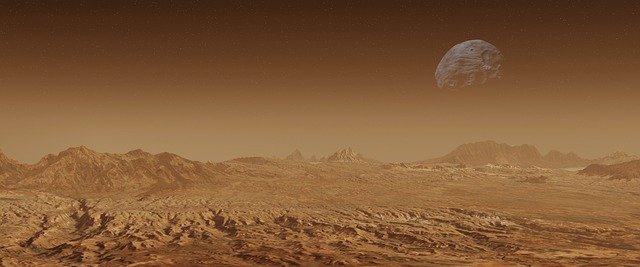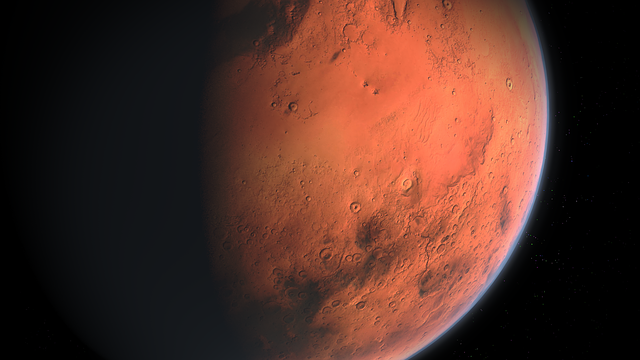*This post may contain affiliate links. This means we may make a commission if you purchase an item using one of our links*
A celestial body is considered to be tidally locked when it rotates around an object at the exact same pace that it orbits that body. Essentially, the length of a day and a year is the same for a tidally locked planet, because it takes the same amount of time to fully rotate on its axis as it does to orbit around the sun.
Mars is not tidally locked as it’s quite rare for planets to be as such. It’s a phenomenon that usually is relevant to moons. Often moons are tidally locked to a planet as opposed to planets to the moons but, this isn’t to say there aren’t the odd few planets tidally locked to a moon.
Why Isn’t Mars Tidally Locked?
Table of Contents
Simply put, there is no object that Mars orbits that it is tidally locked to. First of all, Mars only orbits around one body, that being the Sun.
Mars does not orbit its moons, it’s the moons that orbit Mars.
Mars isn’t tidally locked to anything but, its moons, Deimos and Phobos, are locked tidally to the red planet Mars.
Will Mars Tidally Lock to its Moons and When?

As stated previously, Mars’ moons are tidally locked to it already. So in truth, this question is moot: the moons of Mars are already tidally locked to the planet. They make one full rotation in the time it takes to orbit Mars.
This means the same side of Phobos and Deimos are facing Mars all the time. It is possible for the moons to break their tidal lock with Mars at some point, but such a thing would take an extremely long time.
As for when the moons became tidally locked to Mars, there’s no way to know.
Just like Jupiter and Earth, their moons are tidally locked to them so it isn’t surprising that Mars’ moons are tidally locked to it too.
Now, as for when or if Mars would tidally lock to its moons, its hard to say but, just like Earth with our moon, it probably won’t be the case for at least a few billion years.
Could Mars Tidally Lock to the Earth?
Keep in mind the definition of “tidally locked.” A celestial object can only be tidally locked to an object that they are orbiting (because by definition, they have to rotate at the same speed that they orbit another body). As you may know, Mars does not orbit the Earth.
Therefore, Mars cannot be tidally locked to the Earth. The only celestial body that Mars orbits is the Sun, so Mars could only be tidally locked to the Sun though, it isn’t tidally locked to the Sun either.
What Would Happen if Mars Became Tidally Locked to the Sun?
Over time, it is possible for Mars to become tidally locked to the Sun.
Naturally, being tidally locked to the Sun would mean that only one side of Mars would face the sun all the time. This wouldn’t actually change as much as you think.
Naturally, the side of the planet facing the Sun would have to put up with a lot more solar radiation, but unlike Earth, there isn’t much that would be damaged on the Martian surface.
There’s no vegetation or animals to die, no water to be evaporated, or anything like that.
Truthfully, the biggest change would simply be the temperature on that side of the planet, since it would never get to face the relatively cooler side of the depths of space. But there wouldn’t be much harm in this.
Even the side permanently facing the Sun would still have “seasons,” so to speak, since that is determined by the tilt of the planet, not by the speed of its rotation or orbit.
It’s worth noting that Mars is relatively far from the Sun, meaning the effects of tidal locking on it would be partially mitigated.
Summary
When a celestial body is tidally locked, it rotates on its axis at the same pace that it orbits the body it is tidally locked to. That means the length of a day and the length of a year for that tidally locked planet are the same.
By the definition of what being tidally locked means, Mars can only theoretically be tidally locked to the Sun, which is the only celestial body that Mars orbits. That said, Mars does orbit the Sun, but it does not orbit it at the same rate that Mars itself rotates, meaning it is not tidally locked to the Sun.
On the other hand, Mars does have two moons, Deimos and Phobos. Those moons are tidally locked to Mars, meaning the same face of both moons is facing Mars all the time.
Most tidally locked celestial bodies tend to be moons, though this is not impossible for planets either, Mars is just not one of those planets.
If Mars were to become tidally locked with the Sun, it wouldn’t actually change too much about Mars as a whole, since it has very little on the surface to be affected by never-ending solar radiation. The temperature on that side of the planet would likely increase, but other effects would be minimal.
The distance from the Sun obviously helps.
Ultimately, Mars could become tidally locked to the Sun one day, but it is unlikely to be anytime soon.

